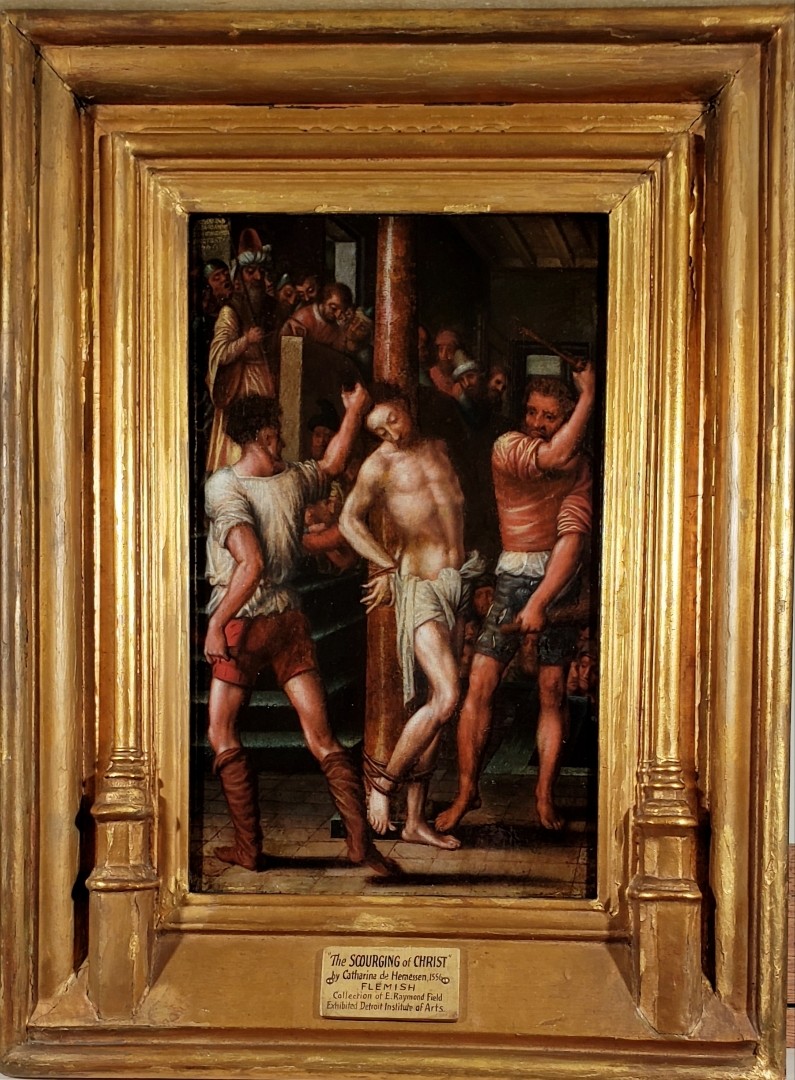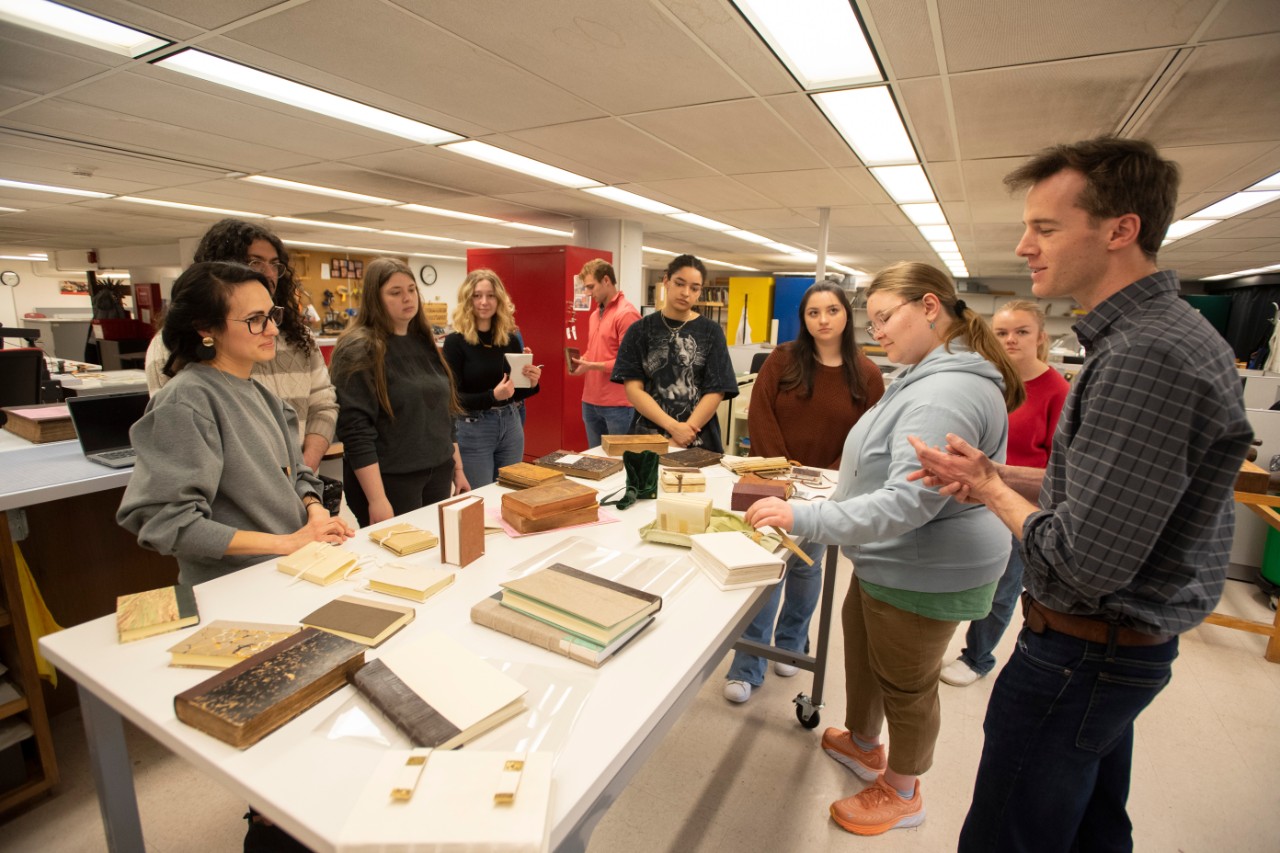Expand Our Impact: An interview with frequent library collaborator Christopher Platts
Christopher Platts, assistant professor of art history, is a frequent collaborator with the Libraries. His work with the DAAP Library, Archives and Rare Books Library and the Preservation Lab, is a perfect example of how we’re achieving our Expand Our Impact Strategic Direction through enhanced UC and external partnerships and collaborations. Following is an interview with Christopher about some of his projects and research focus.
How long have you been at the university and what is your research/teaching focus?
I have been at the University of Cincinnati since autumn 2021, when I moved from the east coast (Connecticut). I teach in the art history and museum studies programs in the School of Art (in DAAP), specifically courses in medieval, Renaissance and Baroque art and architecture. In Museum Studies, I teach the history of exhibitions and display. I also work with the University Honors Program, for which I offer a seminar every two years on the history of collections and collecting at UC, from 1819 to today—a course that draws heavily on UC Library collections and the Preservation Lab.
As for my research, I concentrate on Italian painting and manuscript illumination of the 14th and 15th centuries, especially in Florence, Siena and Venice. I also enjoy searching for and discovering little-known artworks in universities, museums, libraries and churches in Cincinnati, the Tri-State area, and throughout the Midwest.
You are a frequent collaborator with UC Libraries (thank you!). Can you briefly describe some of your past projects with us?
Whether for the sake of teaching, arranging exhibitions of artworks or undertaking public outreach work, collaborating with UC Libraries is one of the highlights of my job. I have worked closely with several librarians to build and display teaching collections of medieval and early modern art, which enhance my courses as well as those of other faculty throughout the university. I find that students respond with greater curiosity and enthusiasm to actual artworks or artifacts that they can examine in person and sometimes even hold in their own hands.

In particular, I work with Elizabeth Meyer, head of the Robert A. Deshon and Karl J. Schlachter Library for Design, Architecture, Art and Planning (DAAP), to acquire medieval and Renaissance illuminated manuscripts and Old Master prints so that we can share them with my medieval art history students. This semester, for instance, I have 40 undergraduates in that course, and we will visit DAAP Library Special Collections once or twice to learn about the materials and techniques of Gothic miniature painters by handling the manuscripts and examining the brushstrokes up close. In previous years, Aaron Cowan, director of the UC Art Collection and DAAP Galleries, has helped Elizabeth and I mount several teaching exhibitions of paintings, prints, and manuscripts in the DAAP Gallery display spaces, so that my students in “Global Renaissance Art and Architecture” and the “History of Exhibitions and Display” can study and analyze the works and the installations. At the same time, these exhibitions are for all of DAAP, UC and the general public, since Elizabeth and I create public programming such as gallery talks and receptions.
(left) Catharina van Hemessen, Scourging of Christ, Oil on Wood Panel, 1556, private collection, Previously on display in the DAAP Library.
More information on exhibitions I have curated with Elizabeth Meyer, Aaron Cowan, and other Library staff members who loaned books or helped with installations, is listed on the DAAP Library website.
Without Chris’s expertise and commitment to teaching with original works, the DAAP Library’s European print collection would not exist. Additionally, when the Dayton Art Institute decided to downsize their library, Chris played a key role in reviewing a list of 12,000 art books to help fill gaps in the DAAP Library’s collection. Co-curating exhibits with Chris is a pleasure and I especially enjoyed working with him and Aaron Cowan on the Hemessen exhibit. We had three lectures and a closing reception with visitors from the Taft Art Museum and Xavier University. I am looking forward to our next exhibit.
Since Chris and I began collaborating, we have added over 100 prints to the collection. The majority of these prints are directly related to the courses he teaches but there are a few prints by Francisco Goya and one by Utagawa Hiroshige. The collection encompasses a broad range of themes, including religious and mythological subjects, portraiture, and landscapes. Additionally, most of the collection, minus new acquisitions, has been digitized and is available for viewing in JSTOR. – Elizabeth Meyer, head of the DAAP Library
The other UC Libraries that I enjoy collaborating with are the Archives and Rare Books Library, John Miller Burnam Classics Library, The Oesper Collections in the History of Chemisty, Albino Gorno Memorial (CCM) Library, and the Donald C. Harrison Health Sciences Library. All of them house medieval or early modern illustrated manuscripts that we can teach with, and several of them have elegant exhibition spaces where museum studies students can observe and critique their installations. Besides my teaching and public outreach efforts, I have spent many enjoyable hours examining the early manuscripts and illustrated printed books in these collections for my own research and future publications.
One other initiative that I am proud of was the Art History Outreach Program, in which eight UC undergraduate and graduate students and I created object-centered presentations for local public high school classes and for a six-week Osher Lifelong Learning Institute course. We used the newly created DAAP Library teaching collection of illuminated manuscripts and old master prints to develop different presentations and then took 10-15 artworks from UC directly to the high school and OLLI classrooms in order to create hands-on experiences for new audiences outside the normal university environment. This effort helped the School of Art and UC Libraries reach new audiences, specifically high school students and OLLI students (over the age of 50) who could not otherwise have had direct access to artworks.
Any shout-outs to specific library workers?
I would like to express my gratitude to not only Elizabeth Meyer but also Cade Stevens; Christopher Harter and Alex Temple (ARB); Rebecka Lindau, Mike Braunlin, Julie Morris, and Yo Shionoyo (Classics Library); Mark Chalmers and Ted Baldwin (Science Library); Jenny Doctor and Suzanne Bratt (CCM Library); and Devhra BennettJones (Henry R. Winkler Center for the History of the Health Professions). I’d also like to thank Holly Prochaska, Catarina Figueirinhas and Jessica Ebert of the Preservation Lab; Erin Smith in Acquisitions; and Amanda Hyden in Cataloguing, as well as many other UC Libraries staff who have helped with countless class visits, library acquisitions and cataloguing, exhibitions and research visits.
Are you working with us on anything currently or in the near future that you’d like to talk about?
I am currently working with Elizabeth Meyer to acquire a beautiful medieval book binding some three feet tall, which preserves its original metal fixings such as clasps, corners and bosses to protect it from wear and tear over the centuries. This amazing object has two manuscript pages with medieval music pasted into the inside covers, making it a fascinating palimpsest that reveals the evolving history of a medieval book. Elizabeth and I are always researching and sharing the objects that we have acquired, including many recently received as donations from locals who have seen our exhibitions in person or online and then simply called us, out of the blue, to offer to donate Old Master prints or manuscripts. These welcome donations have also come to the Archives and Rare Books Library and the Oesper Collections Library, thanks to my work with Chris Harter and Mark Chalmers, among others.
I have proposed a significant exhibition of illuminated manuscripts from Cincinnati collections, including UC Libraries, to the curatorial team at the Taft Museum of Art, and I hope that they will accept my formal proposal in the coming months. This would be a wonderful way to share with the wider public the many treasures of UC Libraries and other repositories in Cincinnati such as the Main Public Library.
As usual, I am excited to visit five or six of the UC Libraries this academic year with my different courses in art history, the museum studies program, and the Honors Program. For more information on the Honors Program seminar and its collaboration with UC Libraries, see this UC News article.

How do you embed distinctive library collections into the curriculum?
I bring my students to the UC Libraries, especially to DAAP Library, the Classics Library, Oesper Collection, and Health Science Library, as often as I can. When I have 25 or 40 students in a class, as I often do, I work with the librarians to come up with two different activities for the students, so that we can manage the class in two groups. Having just 10 or 12 students would be ideal for most of these visits, but thanks to the generous spirit of the librarians and staff, we can accommodate greater numbers and expose more people to the significant collections in the Libraries.
In your words, what value does the library bring to your research? To your students’ work?
The UC Libraries bring immense value to my own research. They provide the primary sources, whether textual or visual, which help me generate questions and ideas about medieval and Renaissance history, art, and science and especially about where those fields intersect.
For my students, the Libraries inspire them to ask new questions and make keen observations that the students would not otherwise make sitting in a classroom far back from a digital screen showing flat representations of artworks and illustrated books. Going forward, I hope to offer more assignments where students study more intensely the illuminated manuscripts and old master prints in our collections, especially the objects we have recently acquired, which are unpublished and little-known.